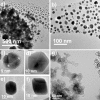Interaction of silver nanoparticles with HIV-1
- PMID: 15987516
- PMCID: PMC1190212
- DOI: 10.1186/1477-3155-3-6
Interaction of silver nanoparticles with HIV-1
Abstract
The interaction of nanoparticles with biomolecules and microorganisms is an expanding field of research. Within this field, an area that has been largely unexplored is the interaction of metal nanoparticles with viruses. In this work, we demonstrate that silver nanoparticles undergo a size-dependent interaction with HIV-1, with nanoparticles exclusively in the range of 1-10 nm attached to the virus. The regular spatial arrangement of the attached nanoparticles, the center-to-center distance between nanoparticles, and the fact that the exposed sulfur-bearing residues of the glycoprotein knobs would be attractive sites for nanoparticle interaction suggest that silver nanoparticles interact with the HIV-1 virus via preferential binding to the gp120 glycoprotein knobs. Due to this interaction, silver nanoparticles inhibit the virus from binding to host cells, as demonstrated in vitro.
Figures




References
-
- Liz-Marzan LM. Nanometals: Formation and color. Materials Today. 2004;7:26–31. doi: 10.1016/S1369-7021(04)00080-X. - DOI
LinkOut - more resources
Full Text Sources
Other Literature Sources

